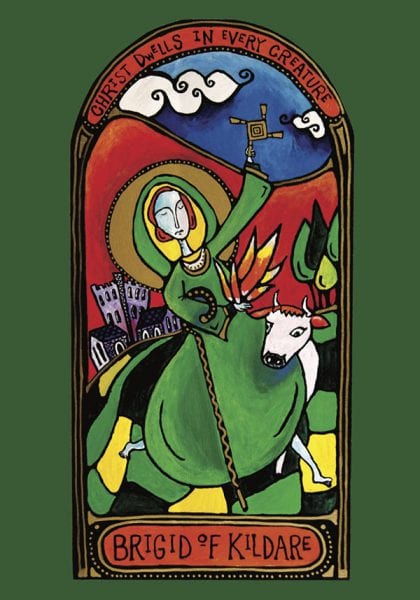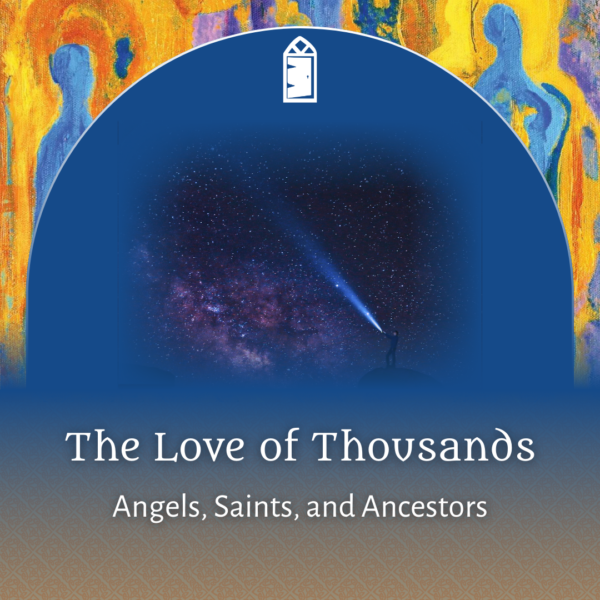 St. Brigid at the Market
St. Brigid at the Market
I saw her in the market
backlit in the doorway
from the evening sun,
blue cloak ripples like water
dandelions and primrose in her hand.
Passersby brush past
this moment of light and song
in a rush to get shoes off
and dinner on, just another day
of traffic, bills, and angry bosses.
I stood, mouth open,
holding three lemons,
a pile of sunlight,
a miracle in yellow,
tiny halos
a little girl stops next to me,
giggles, points to the door,
her mother’s yank
drags her back to the world of lists.
I fear I will forget
this supermarket vision late tonight,
reaching for the bowl of lemons
and simply seeing fruit.
–Christine Valters Paintner
Dearest monks and artists,
February 1st-2nd marks a confluence of several feasts and occasions including: the Celtic feast of Imbolc, St. Brigid’s Day, Candlemas, Feast of the Presentation, and Groundhog Day in the northern hemisphere! (Imbolc is August 1st in the southern hemisphere).
Imbolc is a Celtic feast that is cross-quarter day, meaning it is the midway point between the winter solstice and spring equinox. The sun marks the four Quarter Days of the year (the Solstices and Equinoxes) and the midpoints are the cross-quarter days. In some cultures, like Ireland, February 2nd is the official beginning of spring.
As the days slowly lengthen in the northern hemisphere and the sun makes her way higher in the sky, the ground beneath our feet begins to thaw. The earth softens and the seeds deep below stir in the darkness. The word “imbolc” means “in the belly.” The earth’s belly is beginning to awaken, new life is stirring, seeds are sprouting forth.
In many places the ground is still frozen or covered with snow, but the call now is tend to those very first signs of movement beneath the fertile ground. What happens when you listen ever so closely in the stillness? What do you hear beginning to emerge?
St. Brigid is said to bring the first sign of life after the long dark nights of winter. She breathes into the landscape so that it begins to awaken. Snowdrops, the first flowers of spring are one of her symbols.
On the eve of January 31st it is traditional to leave a piece of cloth or ribbon outside the house. It was believed that St Brigid’s spirit traveled across the land and left her curative powers in the brat Bride (Brigid’s Mantle or cloth). It was then used throughout the year as a healing from sickness and protection from harm.
Often in Ireland, I have heard Brigid described as a bridge between the pre-Christian and Christian traditions, between the other world and this one. She bridges the natural and human world. Brigid sees the face of Christ in all persons and creatures, and overcomes the division between rich and poor. Our practice of inner hospitality as monks in the world is essentially about healing all of places we feel fragmented, scattered, and shamed. One of her symbols is her cloak which becomes a symbol of unity. All can dwell under her mantle.
(The prose section was excerpted from our self-study retreat Sacred Seasons)
The poem above is from my first full collection of poems titled Dreaming of Stones being published by Paraclete Press which you can pre-order and is available in March!
With great and growing love,
Christine
Christine Valters Paintner, PhD, REACE
P.S. Our southern hemisphere dancing monks can find a reflection on Lughnasa at this link>>
Dancing Monk icon of St Brigid © Marcy Hall at Rabbit Room Arts (prints are available in her Etsy shop)


